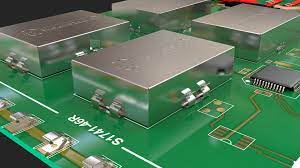Board-level shielding plays a critical role in ensuring the reliable operation of electronic systems in military and aerospace applications. These industries demand robust and resilient electronic devices that can withstand extreme conditions, electromagnetic interference (EMI), and maintain signal integrity. In this article, we will explore the significant role of board-level shielding in military and aerospace applications.
- Electromagnetic Interference (EMI) Protection: Military and aerospace environments are susceptible to high levels of EMI due to various sources such as radar systems, radio communications, power electronics, and pulsed systems. Board-level shielding acts as a protective barrier, containing and minimizing the impact of EMI on sensitive components. Shields made of conductive materials like aluminum or stainless steel help prevent EMI from degrading signal quality, compromising communication systems, or causing malfunctions in critical electronic systems.
- Signal Integrity and Noise Reduction: In military and aerospace applications, maintaining signal integrity is of utmost importance. Noise and interference can corrupt signals, leading to errors, data loss, or even system failure. Board-level shielding provides a conductive enclosure that shields sensitive circuits from external noise sources, minimizing the impact of electromagnetic fields and ensuring accurate and reliable signal transmission. Shielding also helps reduce crosstalk between adjacent traces or components, improving the overall performance of electronic systems.
- Environmental Protection: Military and aerospace environments often expose electronic systems to extreme conditions such as temperature fluctuations, humidity, shock, vibration, and dust. Board-level shielding helps protect sensitive components from these harsh environmental factors, preventing damage and maintaining the integrity of the system. Shields can provide mechanical strength, resistance to shocks and vibrations, and environmental sealing to protect against moisture, dust, and other contaminants.
- Security and Electromagnetic Compatibility (EMC): Military applications often involve sensitive and classified information that must be protected from electromagnetic eavesdropping or interference. Board-level shielding helps contain and minimize electromagnetic radiation emitted by electronic devices, reducing the risk of information leakage or interception. Shielding also contributes to achieving electromagnetic compatibility by ensuring that electronic systems do not interfere with each other, enhancing the overall performance and safety of military and aerospace operations.
- Compliance with Military Standards: Military and aerospace industries have stringent standards and regulations to ensure the reliability and performance of electronic systems. These standards, such as MIL-STD-461 for electromagnetic compatibility and MIL-STD-810 for environmental testing, outline requirements for EMI shielding, environmental protection, and overall system performance. Board-level shielding plays a vital role in meeting these standards and ensuring compliance with military and aerospace specifications.
- Longevity and Reliability: Military and aerospace applications often require long service life and high reliability. Electronic systems must withstand harsh conditions, extended deployments, and demanding operational requirements. Board-level shielding enhances the durability and longevity of electronic devices by protecting critical components from environmental factors, EMI, and physical damage. It contributes to the overall robustness and resilience of the systems, minimizing downtime and ensuring mission-critical operations.
- Ruggedization and Size Constraints: Military and aerospace applications often have specific size and weight constraints due to limited space availability or the need for portability. Board-level shielding can be designed to be lightweight and compact while still providing effective EMI protection and environmental sealing. Advanced shielding materials and techniques, such as conductive coatings or metalized plastics, can help achieve the desired shielding performance while reducing weight and size.
In conclusion, board-level shielding plays a crucial role in military and aerospace applications by protecting electronic systems from EMI, maintaining signal integrity, ensuring environmental protection, enhancing security, complying with industry standards, and providing longevity and reliability. The robustness and resilience offered by board-level shielding are essential for the successful operation of electronic devices in these demanding industries, enabling mission-critical functions, communication systems, and defense capabilities.
